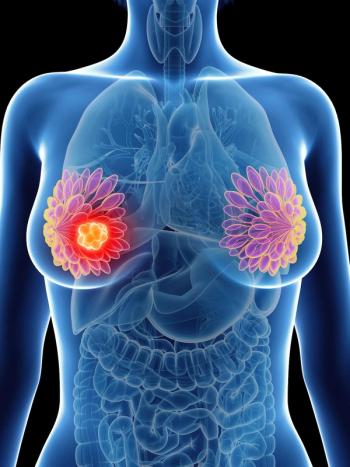
- ONCOLOGY Vol 9 No 5
- Volume 9
- Issue 5
Commentary (Bergsagel): Biologic and Clinical Advances in Multiple Myeloma
Dr. Varterasian presents a broad overview of the biology and treatment of multiple myeloma. It is reassuring to notice her enthusiasm for the new developments in the biology of the disease, because advances in this area should lead eventually to
Dr. Varterasian presents a broad overview of the biology and treatment of multiple myeloma. It is reassuring to notice her enthusiasm for the new developments in the biology of the disease, because advances in this area should lead eventually to improved approaches to treatment. Effective systemic therapy for myeloma began with the demonstration that treatment with melphalan relieves bone pain, causes plasmacytomas to shrink, and decreases myeloma (M) protein levels in 35% to 50% of patients [1]. Subsequent attempts to devise better treatment have led to improved response rates, but have failed to improve patient survival significantly. An imperfect understanding of the cellular biology of myeloma is partially responsible for the failure to make more impressive advances in this field.
Interest in this disease is appropriate because there has been a striking increase in myeloma mortality rates since 1968 in all countries that maintain cancer statistics [2,3]. The rate of increase was greatest in subjects over the age of 85, falling progressively with decreasing age. The rate of increase is substantial by age 70, more than doubling in both sexes and in all countries between 1968 and 1986.
There is much debate about whether the increasing myeloma mortality rates are real, or the result of steadily improving case recognition. The fact that a marked increase in myeloma mortality rates has not been observed in three communities with a high standard of medical care and a long interest in myeloma (Olmstead County, Minnesota; Malmö, Sweden; and Vaud, Switzerland) suggests that the rising myeloma mortality rates in other parts of the world are largely due to improving case ascertainment [4-6]. Kyle et al [6] attribute the flat myeloma mortality rates in Olmstead County to the fact that the Mayo Clinic provides most of the medical care in this county. Hematologists and epidemiologists at the Mayo Clinic have had a major interest in myeloma for many years, and it seems likely that they have succeeded in detecting, and accurately diagnosing, most of the myeloma cases in the county during the 45 years of the study.
We have a major problem in evaluating the response of plasma cell tumors to treatment, because we measure the response in terms of the M-protein-producing cells, which make up the bulk of the tumor. Nathans et al [7] showed that the M-protein is synthesized by the tumor cells of the mouse plasma cell neoplasm X5563, and that the extracellular M-protein pool correlates strongly with tumor weight. Many years later, Salmon and Smith [8] developed a method for measuring the total body M-protein-producing cell mass in myeloma patients, and showed that this value correlated with the degree of skeletal destruction visualized on radiographs.
Estimating Cell-Kill
It is possible to estimate the myeloma cell-kill achieved by treatment by measuring the remission duration from the date that treatment was discontinued to the day the M-protein serum concentration returned to the pretreatment level, and dividing this by the M-protein doubling time during relapse [9]. It has been postulated that, if changes in the M-protein-producing cell mass represent an important aspect of the effectiveness of therapy, we should be able to demonstrate that the myeloma cell-kill, and the degree of M-protein decrement in response to treatment should correlate with survival. In other words, patients in whom the M-protein disappears from the serum electrophoresis pattern following treatment should live longer than those with a 50% fall, who, in turn, should live longer than those with no decrease. However, this hypothesis has been tested, and found to be false [9,10]. In a recent clinical trial testing the value of maintenance melphalan and prednisone, we found that patients who showed "no change" in the M-protein, but remained stable, survived just as well as those who achieved a major fall [11-13].
The fact that responses, measured in terms of shrinkage of the M-protein-producing cell mass, do not correlate with survival prolongation has led us to make important errors in the evaluation of the effectiveness of some drugs, such as corticosteroids. High-dose dexamethasone is the most active agent for lowering the M-protein in refractory myeloma [14], as well as in previously untreated patients [15]. Indeed, dexamethasone was judged to account for most of the responses to the vincristine, Adriamycin, and dexamethasone (VAD) drug combination [14].
The duration of the responses induced by prednisone alone are significantly shorter than those induced by an alkylating agent alone, or combinations of an alkylating agent and prednisone [16]. However, despite this ability to reduce the M-protein-producing cell mass, glucocorticoids have not improved survival in randomized trials of prednisone vs placebo [17], neither in a trial of melphalan and prednisone vs melphalan alone [18], nor in a trial of Adriamycin, BCNU (BiCNU), cyclophosphamide (Cytoxan, Neosar), and melphalan (ABCM) vs this drug combination plus prednisolone (ABCMP) [19].
All of these observations force us to the conclusion that, while a decrease in the M-protein-producing myeloma cell mass does correlate with symptomatic improvement, it does not correlate with prolonged survival. As Dr. Varterasian points out, the M-protein-producing cells are end-stage cells, probably far removed from the important, self-renewing "myeloma stem cell'' compartment. We do not have good assays for myeloma stem cells, since we have been able to grow these cells from only 20% of myeloma patients, usually just from those with aggressive end-stage disease [20], and so we do not know what effect chemotherapy has on them. The fact that treatment, which relieves symptoms by destroying end-stage M-protein-producing cells, does not correlate with improved survival suggests that this treatment does not shrink the myeloma stem cell compartment.
Subsequent survival does correlate well with the duration of the stable "plateau phase" of the response to treatment [12,19], and also with the M-protein- doubling time during the relapse that ends the response [9]. The M-protein-doubling time shortens progressively with each relapse, so that it is not surprising that a short doubling time predicts short survival.
Thus, the criteria we use to evaluate the response to treatment are not very good, and we make serious errors if we try to predict the effect of treatment on survival from the response of the M-protein-producing cell mass.
A Point of Disagreement
I do not agree with Dr. Varterasian's view that the development of drug resistance, and the acquisition of the multidrug resistance (MDR) phenotype, is the major obstacle to treatment of myeloma. Alkylating agents are the drugs we rely on primarily in the treatment of myeloma; acquiring the MDR phenotype does not increase the resistance of myeloma cells to these agents. Drugs such as vincristine and doxorubicin, which may be influenced by the MDR gene, play only a secondary role in some patients. In my view, the discovery of an agent capable of neutralizing the P-glycoprotein efflux pump in myeloma cells with the MDR phenotype would not have a major effect on the survival of patients with myeloma.
A more important type of drug resistance, which develops in myeloma patients as the disease progresses, is what I call "kinetic resistance." We investigated the myeloma cell kill during four successive courses of treatment with melphalan and prednisone [21]. The remission durations shortened progressively from 335 days to 64 days. The shorter remissions did not result from the development of drug resistance by the myeloma cells, since the estimated myeloma cell-kill was .1 following the first course, and 10 to the minus 1.3 power following the fourth course. The remissions shortened because the myeloma regrowth rate increased with each relapse, causing a shortening of the M-protein doubling-time from 98 days to 15. Such kinetic resistance develops in all myeloma patients who manifest disease progression.
Where the Solution Lies
The solution to kinetic resistance will come with the discovery of more effective drugs, capable of eliminating myeloma stem cells. Another possible solution would be the discovery of the biologic mechanism responsible for maintaining the total myeloma cell mass constant in patients with monoclonal gammopathy of unknown significance (MGUS). These patients have an M-protein producing cell mass of at least five billion cells, which remains constant for many years.
About 2% of patients with monoclonal gammopathy of unknown significance progress per year to develop a progressively expanding malignancy such as multiple myeloma, Waldenström's macroglobulinemia, a lymphoma, chronic lymphocytic leukemia, or amyloidosis [22]. The discovery of the biologic change that converts the stable clone in MGUS subjects into an expanding malignancy would be the answer to a dream.
All patients with myeloma probably go through an asymptomatic, stable MGUS phase. If we understood the changes responsible for the conversion to myeloma, we could investigate methods to stabilize the monoclone, and prevent this progression. Also, the myeloma cell mass during the stable plateau phase induced by treatment resembles the monoclone in monoclonal gammopathy of unknown significance in many ways. Therapeutic maneuvers capable of stabilizing the MGUS clone might also stabilize the myeloma cells at the plateau phase of a treatment response.
References:
1. Bergsagel DE: Phase II trials of mitomycin C, AB 100, NSC 1026 L-sarcolysin, and meta-sarcolysin in the treatment of multiple myeloma. Cancer Chemother Rep 16:261-266, 1962.
2. Davis DL, Hoel D, Fox J, et al: International trends in cancer mortality in France, West Germany, Italy, Japan, England and Wales, and the United States. Ann NY Acad Sci 609:5-48, 1990.
3. Schwartz J: Multinational trends in multiple myeloma. Ann NY Acad Sci 609:215-224, 1990.
4. Turesson I, Zettervall O, Cuzik J, et al: Comparison of trends in the incidence of multiple myeloma in Malmö, Sweden, and other countries, 1950 to 1979. N Engl J Med 310:421-424, 1984.
5. Levi F, La Vecchia C: Trends in multiple myeloma. (letter). Int J Cancer 46:755-756, 1990.
6. Kyle RA, Beard CM, O'Fallon WM, et al: Incidence of multiple myeloma in Olmstead County, Minnesota: 1978 through 1990, with a review of the trend since 1945. J Clin Oncol 12:1577-1583, 1994.
7. Nathans D, Fahey JL, Potter M: The formation of myeloma protein by a mouse plasma cell tumor. J Exp Med 108:121-130, 1958.
8. Salmon SE, Smith BA: Immunoglobulin synthesis and total body tumor cell number in IgG multiple myeloma. J Clin Invest 49:1114-1121, 1970.
9. Bergsagel DE: Assessment of the response of mouse and human myeloma to chemotherapy and radiotherapy, in Drewinko B, Humphrey RM (eds): Growth Kinetics and Biochemical Regulation of Normal and Malignant Cells, pp 705-717. Baltimore, Williams & Wilkins, 1977.
10. Palmer M, Belch A, Brox L, et al: Are the current criteria for response useful in the management of multiple myeloma? J Clin Oncol 5:1373-1377, 1987.
11. Belch A, Shelley W, Bergsagel D, et al: A randomized trial of maintenance versus no maintenance melphalan and prednisone in responding multiple myeloma patients. Br J Cancer 57:94-99, 1988.
12. Bergsagel DE: Use a gentle approach for refractory myeloma patients. (editorial). J Clin Oncol 6:757-758, 1988.
13. Bergsagel DE: Plasma Cell Myeloma, in Williams WJ, Beutler E, Erslev EJ, et al (eds): Hematology, pp 1114-1141. New York, McGraw-Hill, 1990.
14. Alexanian R, Barlogie B, Dixon D: High-dose glucocorticoid treatment of resistant myeloma. Ann Intern Med 105:8-11, 1986.
15. Alexanian R, Dimopoulos MA, Delasalle K, et al: Primary dexamethasone treatment of multiple myeloma. Blood 80:887-890, 1992.
16. McIntyre OR, Pajak TF, Kyle RA, et al: Response rate and survival in myeloma patients receiving prednisone alone. Med Pediatr Oncol 13:239-243, 1985.
17. Mass RE: A comparison of the effect of prednisone and a placebo in the treatment of multiple myeloma. Cancer Chemother Rep 16:257-259, 1962.
18. à hre A, Björkholm M, Mellstedt H, et al: Intermittent high-dose melphalan/prednisone vs continuous low-dose melphalan treatment in multiple myeloma. Eur J Cancer Clin Oncol 19:499-506, 1983.
19. MacLennan ICM, Kelly K, Crockson RA, et al: Results of the MRC myelomatosis trials for patients entered since 1980. Hematol Oncol 6:145-158, 1988.
20. Takahashi T, Lim B, Jamal N, et al: Colony growth and self renewal of plasma cell precursors in multiple myeloma. J Clin Oncol 3:1613-1623, 1985.
21. Bergsagel DE, Pruzanski W: Treatment of plasma cell myeloma with cytotoxic agents. Arch Intern Med 135:172-176, 1975.
22. Kyle RA, Lust JA: Monoclonal gammopathies of undetermined significance, in Wiernik PH, Canellos GP, Kyle RA, et al (eds): Neoplastic Diseases of the Blood, 2nd Ed, pp 571-596. New York, Edinburgh, London, Melbourne,
Tokyo, Churchill Livingstone, 1991.
Articles in this issue
over 30 years ago
Gene Mutations Promising as a Test for Early Lung Cancerover 30 years ago
Gene Mutations Promising as a Test for Early Lung Cancerover 30 years ago
Book Review: Cancer Surgeryover 30 years ago
Phase II Prostate Cancer Trial Tests Injectable Gel Treatmentover 30 years ago
Health Care Costs: Market Forces and Reformover 30 years ago
Role of Laparoscopic Techniques in Colorectal Cancer SurgeryNewsletter
Stay up to date on recent advances in the multidisciplinary approach to cancer.



















































































